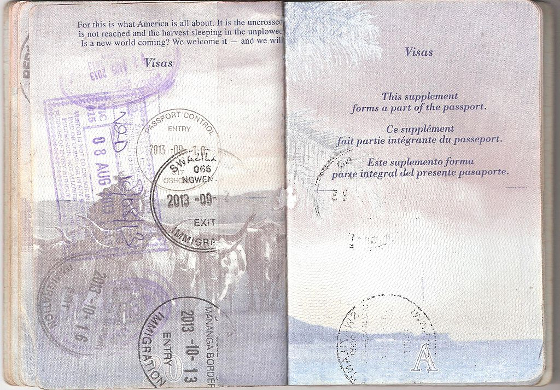
French has appeared alongside English on all U.S. passports starting with the Bicentennial passport – the 1976 design honoring the 200th anniversary of the United States. Initially, the Secretary of State’s message, the descriptive page, and the first visa page all included French translations.
The current American passport (redesigned in 2007) contains descriptions in English, French and Spanish on both the Data Page - the one that contains your photo, identifying information, and the passport’s issuance and expiration dates - as well as the Personal Data and Emergency Contact page.
Spanish translations may seem like an obvious choice since America has a growing Spanish-speaking population and Spanish-speaking tourist destinations throughout Mexico and Central America remain popular.
But why French?
The Short Answer
The League of Nations (the precursor to the modern United Nations) recommended in 1920 that international passports be written in two languages, with French being one of them.
Decades later in 1968, the International Civil Aviation Organization (ICAO) created a “panel of passport experts” to come up with a set of international standards for passports. Among these recommendations was that all passports should be multilingual - including specifically English and French.
At that time, America’s most current passport design was the “Type VIII” which began being issued in 1961. Fifteen years later, 1976 marked the U.S. passport’s first redesign following the creation of ICAO’s recommended standards. Thus the “Type IX” passport, otherwise known as the Bicentennial passport, became the first to feature French translations of key pages alongside the English text.
French has remained in the United States Passport ever since.
The Practical Answer
The U.S. Passport’s Data Page contains the most crucial information for validating a person’s identity. Making this page as widely understandable as possible has obvious benefits to the Passport-holder trying to establish his or her identity.
Sure, customs officials know what they are looking at when they open a traveler’s passport, but others living and working in the traveler’s destination country may not. A multilingual passport can prove quite helpful when trying to prove who you are abroad!
Likewise, the Personal Data and Emergency Contact page is valuable in the event of an emergency or if your passport is lost or stolen. The information you provide on this page (write in pencil – you may need to revise it on occasion) can be used by anyone who comes upon your passport to either reach out to your emergency contact or reunite you with your belongings. Should someone need to use this information, having multilingual descriptions increases the chances that whomever finds your passport can figure out what the information you provided means.
Furthermore, it just makes sense for countries to include languages that match the most common destinations of their travelers.
For Americans, it seems obvious that we should have Spanish translations in our passports. Year after year, Mexico remains one of the most visited international destinations by American tourists. Furthermore, Spanish is currently the second most commonly used language in America.
That said, there are also plenty of French-speaking locations and populations within the sphere of American influence. French is widely spoken in popular travel destinations throughout the Caribbean and the Canadian province of Quebec. There are significant pockets of French-speaking Haitian and Creole populations nestled throughout the United States as well.
Passports are vital forms of identification that are used by people of all ages and backgrounds for a wide variety of purposes. Making them as user-friendly as possible is in the best interest of everyone.
Even now, in the age of machine-readable and biometrically-chipped documents, accounting for language differences matters. Official documents, like passports, are most useful when they can be understood fully by all those likely to interact with them.
The Historical Answer
While French may not be the most widely used language in the world, it has long been considered a key language of international diplomacy. In recent history, English has become the standard language used in official treaties and international documents; however, French was the language of record in international affairs from the eighteenth century through the early twentieth century.
Even now, the diplomatic legacy of the French language persists. To date, French remains one of the official languages of the United Nations. Similarly, French and English are the two official languages of both the Council of Europe and NATO as well as the “working languages” of the International Criminal Court.
It is also worth noting that following the American Revolution, France was the first foreign country to acknowledge America’s independence as a nation. While this may have little to do with the decision to include their language on our official travel documents, it was a nice tip of the cap in 1976 to a nation that played an instrumental role in the creation of our country two centuries prior.
Have more questions about passports or the U.S. passport application process? Click here for our site’s most frequently asked questions and our expert replies.


